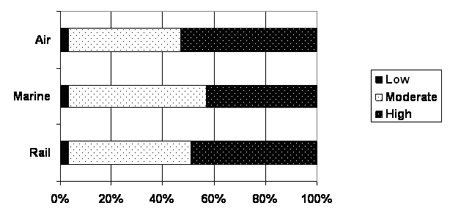Common menu bar links
Breadcrumb Trail
ARCHIVED - Transportation Safety Board of Canada
 This page has been archived.
This page has been archived.
Archived Content
Information identified as archived on the Web is for reference, research or recordkeeping purposes. It has not been altered or updated after the date of archiving. Web pages that are archived on the Web are not subject to the Government of Canada Web Standards. As per the Communications Policy of the Government of Canada, you can request alternate formats on the "Contact Us" page.
Section 2: Analysis of Program Activity
2.1 Performance Management Framework
The TSB's actual performance management framework consists of five key documents. The five-year TSB Strategic Plan is used to set the strategic directions. The Report on Plans and Priorities outlines to parliamentarians and Canadians the results the organization plans to achieve with the resources entrusted to it. The annual Business Plan states the corporate priorities and the key initiatives and activities to support them. It also outlines the key priorities for each branch and division and the resource allocation decisions for the coming year. The Balanced Scorecard defines specific performance indicators and is used by management to measure and monitor progress. This Scorecard will however have to be revised to take into account the comments made by the Treasury Board Secretariat during its assessment of the TSB against the Management Accountability Framework. Finally, the Departmental Performance Report closes the accountability loop by reporting to Parliament on the results achieved.
2.2 Plans and Priorities Commitments
In its 2006-2007 Report on Plans and Priorities, the TSB targeted one strategic result through one program activity. The five priorities listed in Section 1.7 of this document are aimed at supporting and enhancing the TSB's ability to conduct safety investigations and communicate safety information.
In order to optimize the use of resources and to effectively respond to its stakeholders, the TSB has defined four key sectors of service based on the four transportation modes included in its mandate: marine, pipeline, rail and air. This approach enables alignment with the transportation industry and the way it operates.
Resources are therefore allocated and managed separately for each of these key service areas. The table below indicates planned and actual spending on financial and human resources for the key service areas in 2006-2007. Sections 2.7 to 2.10 provide detailed financial information on each key service area of our program activity.
TSB Resources by Key Service Area
| Financial Resources (in thousands of dollars) | ||
| Planned Spending | Actual Spending | |
| Marine | 7,856 | 7,904 |
| Pipeline | 542 | 545 |
| Rail | 7,113 | 7,156 |
| Air | 18,683 | 18,797 |
| Total | 34,194 | 34,402 |
| Human Resources (FTEs) | ||
| Marine | 51 | 49 |
| Pipeline | 4 | 4 |
| Rail | 49 | 48 |
| Air | 129 | 125 |
| Total | 234 | 226 |
2.3 Performance Measurement
The table below illustrates the connections between the TSB's strategic objective, its program activity, its program sub-activities and the results that Canadians can expect, as well as its current performance indicators.
Overview of TSB Program Activity Architecture and Performance Measurement Framework
| Program Activity Architecture Level | Definition | Results | Indicators |
| Strategic Outcome | To advance transportation safety, thereby reducing risks to people, property and the environment | Increased awareness of safety issues and a strengthened safety culture on the part of governments, industry and public | • Implementation of the Outreach Program • Availability of safety information and other transportation safety information on the web • Stakeholder and client awareness of TSB profile and impact of its activities • Cost of Business Plan projects • Safety outputs issued • Assessment of responses to TSB recommendations |
| Name | Expected Results | ||
| Program Activity | Safety Investigations | Timely implementation of safety actions by stakeholders to improve transportation safety for Canadians | • Cost of Business Plan projects • Timely safety actions taken |
| Program Sub-Activities |
1. Air Investigations 2. Marine Investigations 3. Rail/Pipeline Investigations 4. Professional and Communications Services |
Identification and communication to stakeholders and the public of safety deficiencies in the transportation system | • Number of transportation occurrences • Number of investigations started, in process and completed • Duration of completed investigations • Net cost of completed investigations by sector • Average net cost per investigations completed • Number of investigations started and completed by investigator • Number of safety outputs issued • Number of safety actions taken |
It should be noted that the data used in this report come from TSB information systems unless otherwise specified.
In 2006, the TSB underwent an initial assessment against the Management Accountability Framework (MAF). The observations made by the Treasury Board portfolio show that the Department would benefit from improving its Program Activity Architecture (PAA) by reviewing its strategic result to make it more measurable and more focused on TSB responsibilities. The new architecture should also enable the Department to strengthen the links between expected results and progress made toward achieving those results.
The Department will follow up on these comments in 2007-2008 with a view to implementing them in the 2008-2009 fiscal year. This will include reviewing the above table to bring it into line with the Department's new PAA and to incorporate all the information required under the Management, Resources, and Results Structure Policy.
2.4 Report on Transportation Occurrences
In 2006, a total of 1,921 accidents and 1,326 incidents were reported in accordance with the TSB's regulations for mandatory reporting of occurrences.1 The number of accidents in 2006 decreased by 6 per cent from the 2,046 accidents reported in 2005 and by 1 per cent from the 2001-2005 annual average of 1,946 accidents. The number of reported incidents decreased to 1,326 in 2006, down from 1,371 in 2005 and the 2001-2005 average of 1,414. There were also 564 voluntary incident reports. Fatalities totalled 168 in 2006, down 20 from the 2005 total and 21 from the 2001-2005 average.
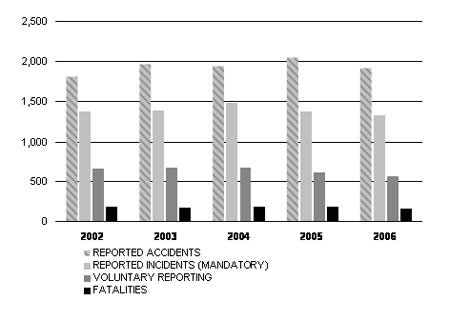 |
|
Figure 1. |
Table 1 presents data on accident rates by sector for the current year, as well as the five-year average. Even if these rates are based on limited data, activity level indicators provide a general point of reference on transportation safety. Overall, Canada continued to maintain a good safety record in 2006. The 2006 accident rates, per activity level for all sectors, reflect a downward trend from the five-year average.
|
Table 1: |
Accident Rates in Transportation by Sector in 2006 Compared to the Previous Five-Year Average (2001-2005) |
| Accidents | Marine1 | Pipeline2 | Rail3 | Air4 |
| 2006 | 3.3 | 0.6 | 2.4 | 6.2 |
| 2005 | 3.6 | 0.4 | 3.1 | 6.2 |
| Five-Year Average | 3.6 | 1.2 | 2.8 | 7.1 |
| 1 Canadian-flag shipping accidents for vessels with a gross tonnage of 15 or more (excluding passenger vessels, passenger ferries and fishing vessels) per 1,000 movements. 2 Per exajoule. 3 Accidents (other than crossing or trespasser accidents) that occur on a main track or spur per million main-track train-miles. Since April 1, 2005, the accidents that occurred on former BC Rail's network are included. 4 Canadian-registered aircraft accidents (excluding ultralights, gliders, balloons and gyrocopters) per 100,000 hours. |
||||
Reported accidents and incidents provide indicators of the transportation system's safety performance and help focus efforts on those initiatives and activities that have high safety benefits. Table 2 presents the statistics on transportation occurrences by sector, including comparisons with the five-year average. Taking into account the level of activity in each sector, the number of accidents for 2006 continued to exhibit a general downward trend in the marine, pipeline and air sectors, while the rail sector is still slightly above the average.
The number of incidents for 2006 also continued to exhibit a downward trend in the marine, rail and air sectors. The number is still higher than the average in the pipeline sector.
Another indicator of the safety performance of the transportation system is the number of fatalities. In 2006, the marine and rail sectors showed a decrease in fatalities compared to the five-year average, and the fatalities in the air sector were the same as the five-year average. A reduction in accidents and fatalities would be expected to positively influence the public's confidence in the safety of the transportation system.
|
Table 2. |
Transportation Occurrences by Sector in 2006 Compared to the Previous Five-Year Average (2001-2005) |
| Marine | Pipeline | Rail* | Air | |
| Accidents | ||||
| 2006 | 467 | 8 | 1,144 | 262 |
| 2005 | 489 | 5 | 1,247 | 258 |
| Five-Year Average | 506 | 15 | 1,091 | 275 |
| Fatalities | ||||
| 2006 | 18 | 0 | 95 | 52 |
| 2005 | 20 | 0 | 103 | 51 |
| Five-Year Average | 25 | N/A | 96 | 52 |
| Incidents | ||||
| 2006 | 212 | 63 | 226 | 823 |
| 2005 | 227 | 79 | 243 | 822 |
| Five-Year Average | 222 | 52 | 283 | 857 |
| *Since April 1, 2005, occurrences on the former BC Rail's network are included in the number of occurrences. | ||||
Despite fluctuations in the number of accidents and incidents reported on an annual basis, the trend over the past 10 years shows a progressive decline in accident rates in all transportation sectors (see the figures for each sector in sections 2.7 to 2.10). Therefore, Canada has one of the safest transportation systems in the world and continues to work diligently to improve it further. These improvements in transportation safety are the result of the combined efforts of many stakeholders including manufacturers, carriers, crews, regulators, and the TSB. All these efforts are also reflected in the results of a survey conducted by EKOS Research Associates in February 2007, which indicated that 97.3 per cent of those Canadians who had an opinion on the subject rated the air, rail and marine transportation systems as moderately or very safe and secure.
|
How would you rate the safety and security of each of the following modes of transportation?
Nota : Road statistics have been removed from the figure. |
|
Figure 2. |
Level of Public Confidence in the Safety and Security of the Air, Rail and Marine Travel Modes[D]f2 |
More comprehensive transportation safety information is available on the TSB website or in Chapter 4 of the Transportation in Canada 2006: Annual Report published by Transport Canada.
2.5 Investigations and Safety Action
All reported occurrences were examined in accordance with the Board's Occurrence Classification Policy to identify those with the greatest potential for advancing transportation safety. Information was entered into the TSB database for historical record, trend analysis and safety deficiency validation purposes. Investigations were undertaken for 68 of the approximately 4,000 occurrences reported to the TSB in fiscal year 2006-2007. In that same period, 57 investigations were completed, compared to 75 in the previous year.2 Out of the 57 investigations completed, 44 per cent (25) had started more than two years ago. This backlog was more pronounced in the marine and rail sectors where respectively 78 per cent and 67 per cent of the investigations completed had started more than two years ago.
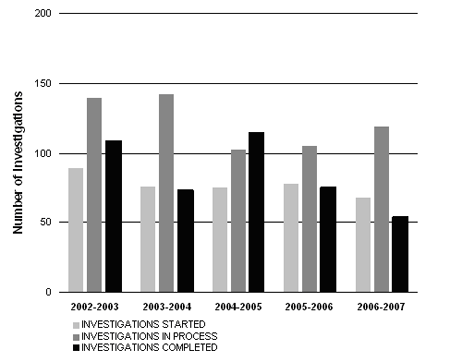 |
|
Figure 3. |
The number of investigations in process increased to 119 at the end of the fiscal year from 105 at the start. Average time to complete an investigation increased to 573 days in fiscal year 2006-2007 from 464 days in the previous year. Of the 119 investigations in progress at year end, 16 were more than two years old, 36 were between one and two years old, and 67 were less than one year old. The backlog is particularly pronounced in the marine sector, where 68.8 per cent of the investigations in progress were more than two years old.
While overall report timeliness has shown some improvements in recent years, there was a significant increase in 2006-2007. The reduction in the number of investigations completed and the increase in the average time to complete investigations were the result of a combination of factors. The increase in the number of major investigations, a concerted effort to complete older investigations as well as unanticipated management and staff shortages all contributed to this increase. The TSB has recently completed staffing of a number of key positions, including short-term hiring. This should allow it to improve its performance. In addition, the organization will undertake a full review of its operations in 2007-2008 to ensure optimal allocation of available resources for the achievement of its mandate and goals.
|
Table 3. |
TSB Productivity by Sector |
| Marine | Pipeline | Rail | Air | Total | ||||||
| 2005- 2006 |
2006- 2007 |
2005- 2006 |
2006- 2007 |
2005- 2006 |
2006- 2007 |
2005- 2006 |
2006- 2007 |
2005- 2006 |
2006- 2007 |
|
| Investigations Started | 17 | 8 | 2 | 1 | 9 | 18 | 50 | 41 | 78 | 68 |
| Investigations Completed | 12 | 8 | 1 | 1 | 9 | 12 | 53 | 36 | 75 | 57 |
| Average Duration of Completed Investigations (Number of Days) | 651 | 801 | 922 | 407 | 519 | 598 | 404 | 516 | 464 | 573 |
| Note: Results can fluctuate significantly from year to year due to a number of factors such as staff turnover, the complexity of investigations and the investigation of major occurrences. | ||||||||||
Overall, the TSB has been successful in identifying safety deficiencies and in reducing risks in the transportation system. TSB investigations result in reports identifying safety deficiencies and, where appropriate, containing recommendations to reduce risks. Over this past year, in all cases where the TSB undertook an investigation, safety deficiencies or contributing factors were identified and communicated. These results reflect careful application of the TSB's Occurrence Classification Policy in deciding whether to investigate, and a thorough implementation of the investigation methodology. This systematic approach ensures that TSB investigation resources are invested in areas with the greatest potential safety payoffs.
In 2006-2007, in addition to investigation reports, the TSB issued a total of 61 safety outputs: 6 recommendations, 32 safety advisories and 23 safety information letters (see Table 4 for a breakdown by sector).
|
Table 4. |
Safety Outputs by the TSB |
| Sector | Recommendations3 | Safety Advisories | Safety Information Letters |
| Marine | 0 | 8 | 8 |
| Pipeline | 0 | 0 | 1 |
| Rail | 2 | 8 | 2 |
| Air | 4 | 16 | 12 |
| Total | 6 | 32 | 23 |
| Note: In 2006-2007, a total of 3 marine safety concerns, 3 rail safety concerns and 6 air safety concerns were identified. | |||
Safety information is also provided informally to key stakeholders throughout the investigation process, permitting them to take immediate safety actions where appropriate. It is common practice for industry and government to take safety actions during the course of TSB investigations. Such safety actions range widely in scope and importance. Operators will often take immediate remedial action after discussion with TSB investigators (for example, to clear the sight-lines at a railway crossing by trimming bushes and vegetation). Regulators such as Transport Canada and the Federal Aviation Administration in the United States regularly issue mandatory directives requiring inspections and/or component replacement based on the TSB's preliminary findings. In such situations, rather than issuing recommendations, the TSB can then report on the corrective actions already taken by industry and government agencies.
| In response to the Transportation Safety Board's report and recommendations released in February 2006 following a non-fatal engine room fire on the BC Ferries Queen of Surrey in British Columbia, Transport Canada today committed to reviewing international marine regulations and standards for fixed fire-extinguishing systems to ensure that
future regulations meet or exceed international standards. "Transport Canada's top priority for Canadian ferries is to develop and maintain regulations that help ensure the safe passage of people and goods," said the Minister of Transport, Infrastructure and Communities. Source: News Release, No. H032/06, May 9, 2006, Transport Canada |
In accordance with the Canadian Transportation Accident Investigation and Safety Board Act, a federal minister who is notified of a TSB recommendation must, within 90 days, advise the Board in writing of any action taken or proposed to be taken in response, or the reasons for not taking action. The Board considers each response, assessing the extent to which the related safety deficiency was addressed. When a recommendation generates responses from within and outside Canada, the Board's assessment is based primarily on the Canadian response. Assessment of industry and government organization responses to recommendations made after January 1, 2005 can be found on the TSB website.
|
Table 5. |
Board Assessment of Responses to Recommendations |
| Responses Received in Fiscal Year 2006-2007 | Fully Satisfactory Attention to Safety Deficiency | Satisfactory Intent to Address Safety Deficiency | Attention to Safety Deficiency Satisfactory in Part | Unsatisfactory Attention to Safety Deficiency | To be Assessed | Total |
| Marine | 1 | 0 | 2 | 0 | 0 | 3 |
| Pipeline | 0 | 0 | 0 | 0 | 0 | 0 |
| Rail | 0 | 0 | 0 | 0 | 2 | 2 |
| Air | 2 | 3 | 2 | 0 | 3 | 10 |
| Total | 3 | 3 | 4 | 0 | 5 | 15 |
2.6 |
Communicating Transportation Safety to Canadians and the Transportation Community |
|
One of the central challenges in advancing transportation safety has been convincing the many actors in the industry that change is necessary to lessen the risk. This has led the TSB to adopt a number of tools to convey the findings achieved through investigations. During the past year, the TSB identified a number of safety deficiencies and delivered key safety messages to the public, industry and regulators. As in past years, that approach has proved to be quite effective and continues to be supported to increase effectiveness. In an effort to improve the uptake of its recommendations, the TSB has begun to target its safety messages to narrower and more specialized audiences who are in a position to act directly. The Outreach Program was developed to promote safety where specific departments, elected officials and industry leaders have an important role to play. To that end, the TSB has identified the need to become more active with its Outreach Program and is striving to increase the number of outreach opportunities that are undertaken each year by the Chair, Board members, senior executives and staff. We anticipate that this effort will be rewarded in years to come as we expand the reach of our messages and the safety of Canada's transportation system continues to improve. |
In June 2006, a new Executive Director of the TSB was appointed. One of his first challenges was to meet with representatives from the transportation industry and other interested parties. Over four months, the Executive Director met with various airline companies, rail operators, manufacturers, transportation associations, airport authorities, and medical examiners. He made a presentation to the Railway Association of Canada and attended a number of safety association meetings and conferences.
TSB staff and Board members also participated in various conferences and technical meetings pertinent to transportation safety to keep abreast of technological change and to make presentations on safety issues of particular interest to the audiences. To complement these meetings, the TSB wrote and distributed technical and feature articles that have been published in specialized magazines. In these ways, the TSB has taken advantage of various forums as opportunities to share lessons learned from its investigations.
The TSB published 57 investigation reports in 2006-2007, as well as monthly and annual statistical reports, and continues to maintain a proactive approach to the dissemination of information. Pertinent information is made readily available to industry, next-of-kin, the media and the public throughout the investigation process. Investigators are encouraged to maintain a dialogue with key stakeholders, including the early communication of safety issues that arise during investigations. The TSB tries to satisfy both the public and the media's expectation for up-to-date factual information. In 2006-2007, 631 subscribers joined its website for a total of 2,065 subscribers, and the TSB responded to 749 information requests received through its website and 643 media calls, not including those inquiries handled at an accident site or at a report release news conference. The TSB attended 3 outreach events, held 6 news conferences and issued 19 news releases. The TSB Macro-Analysis Division responded to 370 requests for complex transportation occurrence database information.
The TSB also uses its website to increase awareness of safety issues and other transportation safety information. The TSB website received an average of more than 92,930 daily hits and 6,409 daily visits, a 32 per cent increase in daily visits over the previous year. The visitors are Canadians and people from all around the world. This increased traffic over the years, shown in Table 6 below, can partly be attributed to the media coverage given to certain accidents, the press releases issued by the TSB, the ease of access to the site and the vast amount of information found there. Although it is difficult to measure the results of TSB activity in this area, tangible signs continue to point toward a certain degree of effectiveness in achieving the desired outcome. Stakeholders and the media make use of TSB safety messages in their activities. There is a sustained level of interest, both in Canada and around the world, in TSB techniques and methodologies.
|
Table 6. |
Number of Requests for Information Received by the TSB |
| 2003-2004 | 2004-2005 | 2005-2006 | 2006-2007 | |
| Website: | ||||
| • Daily hits | 49,000 | 51,000 | 86,700 | 92,930 |
| • Daily visits | 1,860 | 2,300 | 4,870 | 6,409 |
| • Requests for information | 1,357 | 1,289 | 1,284 | 749 |
| Media calls | 424 | 528 | 431 | 643 |
| Requests for complex database information | 632 | 602 | 593 | 370 |
2.7 Marine Sector
2.7.1 Annual Statistics
In all, 467 marine accidents were reported to the TSB in 2006, a 4 per cent decrease from the 2005 total of 489 and an 8 per cent decrease from the 2001-2005 average of 506. Marine fatalities totalled 18 in 2006, down from both the 2005 total of 20 and the 2001-2005 average of 25.
Shipping accidents, which comprised 90 per cent of marine accidents, reached a 30-year low of 419 in 2006, down from 444 in 2005 and from the five-year average of 455. Nearly half of all vessels involved in shipping accidents were fishing vessels. Accidents to persons aboard ship, which include falls, electrocution, and other types of injuries requiring hospitalization, totalled 48 in 2006, a 7 per cent increase from the 2005 total of 45 but a 6 per cent decrease from the five-year average of 51.
Marine activity for Canadian commercial non-fishing vessels (excluding passenger vessels and cruise ships) increased by 1 per cent from the 2001-2005 average, resulting in a 7 per cent decrease in the accident rate from 3.6 to 3.3 accidents per 1,000 movements. Although marine activity for foreign commercial non-fishing vessels remained relatively unchanged compared to the 2001-2005 average, accidents increased, yielding an 11 per cent increase in the accident rate from 1.6 to 1.8 accidents per 1,000 movements.
In 2006, shipping accidents resulted in 12 fatalities, down from 13 in 2005 and the five year average of 16. Accidents aboard ship resulted in 6 fatalities, down 1 from the 2005 total and down 3 from the five-year average.
Thirty-one vessels were reported lost in 2006, up from the 2005 total of 26 but down from the five-year average of 34.
In 2006, 212 marine incidents were reported to the TSB in accordance with the mandatory reporting requirements. This represents a 7 per cent decrease from the 2005 total of 227 and a 5 per cent decrease from the five-year average of 222.
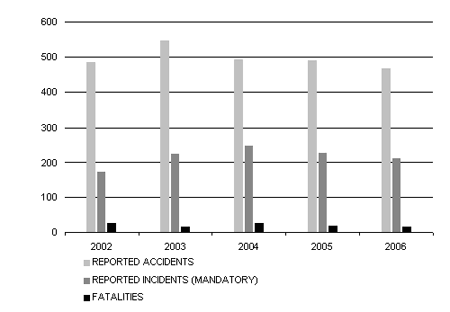 |
|
Figure 4. |
One indicator of marine safety in Canada is the Canadian-flag shipping accident rate. This accident rate has decreased from 3.7 accidents per 1,000 movements in 2005 to 3.3 in 2006, but no significant statistical trend was found.
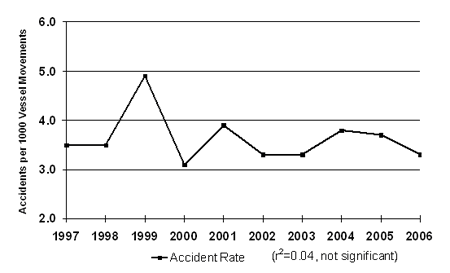 |
|
Figure 5. |
2.7.2 Investigations
In 2006-2007, 8 marine investigations were started and 8 investigations were completed. This represents a decrease (from 12 to 8) of the number of investigations completed compared to 2005-2006. The decrease is still linked to the delay to staff vacant positions. The average duration of completed investigations increased to 801 days, compared to 651 days the year before and an average of 797 days between 2002-2003 and 2005-2006. This is attributable to concentrated efforts to complete older investigations. A complete list of all marine reports released in 2006-2007 can be found in Appendix A.
|
Table 7: |
Marine Productivity |
| 2002-2003 | 2003-2004 | 2004-2005 | 2005-2006 | 2006-2007 | |
| Investigations Started | 13 | 14 | 16 | 17 | 8 |
| Investigations Completed | 15 | 18 | 21 | 12 | 8 |
| Average Duration of Completed Investigations (Number of Days) | 703 | 953 | 881 | 651 | 801 |
| Recommendations | 5 | 7 | 4 | 6 | 0 |
| Safety Advisories | 7 | 6 | 9 | 5 | 8 |
| Safety Information Letters | 14 | 11 | 8 | 8 | 8 |
| Note: Results can fluctuate significantly from year to year due to a number of factors such as staff turnover, the complexity of investigations and the investigation of major occurrences. | |||||
2.7.3 Link to Resources Utilized
Table 8 shows the net costs of marine investigations for Canadians. Net costs increased over the previous fiscal year. The average net cost per completed investigation increased by 62.5 per cent due to various factors, including the costs of the operations undertaken during the large-scale investigation of the sinking of the Queen of the North ferry off the coast of Prince Rupert, British Columbia, as well as overtime worked to compensate for a lack of investigators. The average duration of completed investigations also increased, and the number of investigations undertaken and completed by investigator decreased over 2005-2006 by 53 per cent and 34 per cent respectively. This is also attributable to the ongoing complex investigation and a decision to limit the number of new investigations in this sector until the backlog has been dealt with.
|
Table 8: |
Marine Resources |
| 2005-2006 | 2006-2007 | |||
| FTEs | In thousands of dollars | FTEs | In thousands of dollars | |
| Actual Costs - Marine | 22.9 | 2,797 | 22.9 | 3,130 |
| Internal Professional and Communication Service Costs | 17.7 | 1,823 | 16.1 | 1,840 |
| Corporate Services Costs | 10.7 | 1,196 | 10.3 | 1,343 |
| Contributions to Employee Benefit Plans | 781 | 782 | ||
| Services Received Without Charge | 696 | 808 | ||
| Net Cost of Investigations | 51.3 | 7,294 | 49.3 | 7,904 |
| Indicators | 2005-2006 | 2006-2007 | ||
| Number of Investigators | 20.4 | 20.6 | ||
| Average Net Cost per Investigation Completed | $607,820 | $987,946 | ||
| Investigations Started by Investigator | 0.83 | 0.39 | ||
| Investigations Completed by Investigator | 0.59 | 0.44 | ||
2.7.4 Safety Actions Taken
No marine safety recommendations were issued in 2006-2007.
The Marine Branch assessed responses to 3 recommendations issued in 2005-2006 (details can be found in Appendix B) and reassessed responses to 42 published recommendations issued in previous years. With Board approval, 9 recommendations went from active to inactive status and 33 recommendations remained active. The Board's reassessments were communicated to the appropriate change agent(s) for information and action.
2.7.4.1 Other Marine Safety Actions
BC Ferries implemented additional procedures to ensure that bridge officers and quartermasters are familiarized with new bridge equipment. TSB Marine Safety Advisory 07/06 on the adequacy of crew familiarization with equipment was sent to BC Ferries following the sinking of the ferry Queen of the North (TSB Occurrence M06W0052).
BC Ferries implemented a new procedure for establishing passenger manifests to ensure that the passengers on board its vessels on northern routes are accurately reflected in the passenger manifests maintained ashore. TSB Marine Safety Advisory 09/06 on the adequacy of current guidelines for creating ferry passenger manifests was sent to Transport Canada (TC) and copied to BC Ferries following the sinking of the ferry Queen of the North (TSB Occurrence M06W0052).
TC met with industry and government representatives to discuss updating current port procedures for the handling of dangerous cargo at the Port of Saguenay, Quebec. A small explosion had occurred on board a vessel unloading a cargo of explosives (TSB Occurrence M06L0045). TC decided to deploy an inspector to the site when notified of a shipment of dangerous cargo at the port. Also, TC informed the Swedish and German port authorities involved (where the vessel was loaded) of the incident and of the handling and loading of the cargo at the port of loading. TSB Marine Safety Advisory 08/06 on the inadequate explosive cargo handling practices was sent to TC and the Port of Saguenay.
2.8 Pipeline Sector
2.8.1 Annual Statistics
In 2006, 8 pipeline accidents were reported to the TSB, up from the 2005 total of 5 but down from the 2001-2005 average of 15. Pipeline activity is estimated to have increased by 2 per cent from the previous year. The last fatal pipeline accident in the portion of the industry under federal jurisdiction occurred in 1988, and the last accident involving serious injury occurred in 2000.
In 2006, 63 pipeline incidents were reported to the TSB in accordance with the mandatory reporting requirements, down from 79 in 2005 but up from the five-year average of 52. In all, 88 per cent of those incidents involved uncontained or uncontrolled release of small quantities of gas, oil and high-vapour-pressure products.
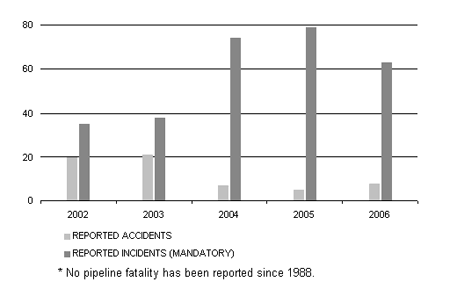 |
|
Figure 6. |
One indicator of pipeline transportation safety in Canada is the pipeline accident rate. This rate increased to 0.6 pipeline accidents per exajoule in 2006, up from 0.4 in 2005 but down from the 2001-2005 average of 1.2. The trend line also indicates a clear downward direction.
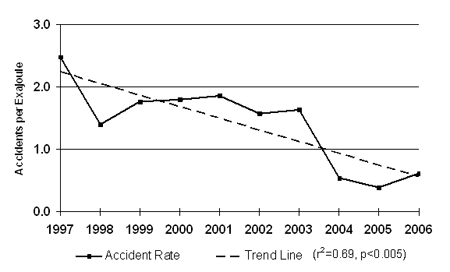 |
|
Figure 7. |
2.8.2 Investigations
In 2006-2007, one pipeline investigation was started and one investigation was completed. The completed investigation required 407 days, a significant decrease from the 922 days required in 2005-2006 (the latter was a very complex investigation that required a high degree of effort to gather and analyze the data). Details regarding the pipeline report released in 2006-2007 can be found in Appendix A.
|
Table 9: |
Pipeline Productivity |
| 2002-2003 | 2003-2004 | 2004-2005 | 2005-2006 | 2006-2007 | |
| Investigations Started | 2 | 0 | 0 | 2 | 1 |
| Investigations Completed | 2 | 0 | 2 | 1 | 1 |
| Average Duration of Completed Investigations (Number of Days) | 410 | 0 | 1,081 | 922 | 407 |
| Recommendations | 0 | 0 | 0 | 0 | 0 |
| Safety Advisories | 0 | 0 | 0 | 0 | 0 |
| Safety Information Letters | 1 | 0 | 0 | 0 | 1 |
| Note: Results can fluctuate significantly from year to year due to a number of factors such as staff turnover, the complexity of investigations and the investigation of major occurrences. | |||||
2.8.3 Link to Resources Utilized
Table 10 provides a picture of the net cost to Canadians of pipeline investigations. The net cost of pipeline investigations increased slightly compared to 2005-2006. One investigation was started and one was completed during the year.
|
Table 10: |
Pipeline Resources |
| 2005-2006 | 2006-2007 | |||
| FTEs | In thousands of dollars | FTEs | In thousands of dollars | |
| Actual Costs - Pipeline | 2.0 | 203 | 2.0 | 216 |
| Internal Professional and Communication Service Costs | 1.5 | 133 | 1.4 | 127 |
| Corporate Services Costs | 0.9 | 87 | 0.9 | 93 |
| Contributions to Employee Benefit Plans | 57 | 54 | ||
| Services Received Without Charge | 51 | 56 | ||
| Net Cost of Investigations | 4.4 | 531 | 4.3 | 545 |
| Indicators | 2005-2006 | 2006-2007 | ||
| Number of Investigators | 1.8 | 2.0 | ||
| Average Net Cost per Investigation Completed | $530,584 | $545,422 | ||
| Investigations Started by Investigator | 1.11 | 0.5 | ||
| Investigations Completed by Investigator | 0.56 | 0.5 | ||
2.8.4 Safety Actions Taken
No pipeline safety recommendations were issued in 2006-2007.
2.8.4.1 Other Pipeline Safety Actions
In response to the Pipeline Safety Information letter, the National Energy Board issued a Safety Advisory to all companies under its jurisdiction, as well as to the Canadian Energy Pipeline Association, the Canadian Association of Petroleum Producers and provincial regulators. The Safety Advisory outlined safety issues related to potential employee injury from ejection of pipeline pigs that have been lodged in receiving traps. Additionally, it itemized actions for organizations to take to address that risk in the future.
2.9 Rail Sector
2.9.1 Annual Statistics
A total of 1,144 rail accidents were reported to the TSB in 2006, an 8 per cent decrease from the 2005 total of 1,247 but a 5 per cent increase from the 2001-2005 average of 1,091. Rail activity is estimated to be comparable to 2005 and to have increased by 4 per cent over the five-year average. The accident rate decreased to 11.9 accidents per million train-miles in 2006, compared to 13.0 in 2005 and the five-year rate of 11.9. Rail-related fatalities totalled 95 in 2006, compared to 103 in 2005 and the five-year average of 96.
Three main-track collisions occurred in 2006, compared to six in 2005 and the five-year average of six. In 2006, there were 133 main-track derailments, a decrease of 31 per cent from the 2005 total of 194 and 10 per cent from the five-year average of 148. Non-main-track derailments decreased to 480 in 2006 from 540 in 2005, but increased from the five-year average of 422.
In 2006, crossing accidents decreased to 248 from the 2005 total of 269 and from the five-year average of 260. Crossing-related fatalities numbered 28, down from 37 in 2005 and the five-year average of 35. Trespasser accidents decreased by 8 per cent to 59 in 2006 from 64 in 2005, but increased by 4 per cent over the five-year average of 57. With a total of 94 fatalities in 2006, trespasser accidents continue to account for the majority of rail fatalities.
In 2006, 181 rail accidents involved dangerous goods (this also includes crossing accidents in which the motor vehicle is carrying a dangerous good), down from 214 in 2005 and from the five-year average of 215. Three of these accidents resulted in a release of product.
In 2006, rail incidents reported to the TSB in accordance with the mandatory reporting requirements reached a 24-year low of 226, down from 243 in 2005 and the five-year average of 283. For the first time, movements exceeding limits of authority incidents (101) comprised the largest proportion of the 226 reportable incidents, surpassing dangerous goods leaker incidents (86).
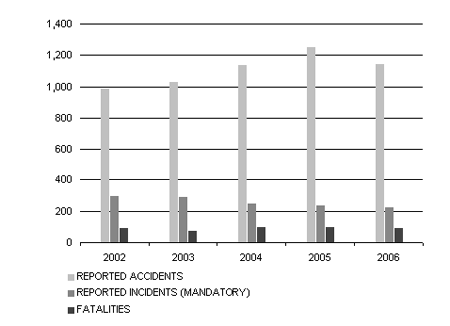 |
|
Figure 8. |
One indicator of rail transportation safety in Canada is the main-track accident rate. This rate decreased from 3.1 accidents per million main-track train-miles in 2005 to 2.4 in 2006. Over the past 10 years, the downward trend approaches statistical significance.
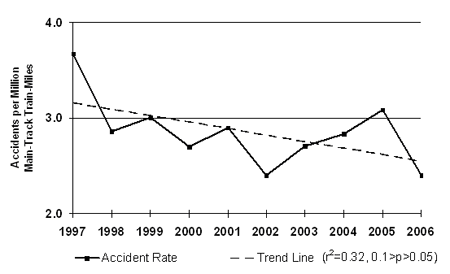 |
|
Figure 9. |
2.9.2 Investigations
A total of 18 rail investigations were undertaken in 2006-2007 compared to 9 the previous year. The number of investigations completed aslo slightly increased from 9 to 12 this fiscal year. The average duration of completed investigations increased to 598 days compared to 519 days the year before. A complete list of all rail reports released in 2006-2007 can be found in Appendix A.
|
Table 11: |
Rail Productivity |
| 2002-2003 | 2003-2004 | 2004-2005 | 2005-2006 | 2006-2007 | |
| Investigations Started | 18 | 14 | 14 | 9 | 18 |
| Investigations Completed | 22 | 15 | 25 | 9 | 12 |
| Average Duration of Completed Investigations (Number of Days) | 755 | 894 | 618 | 519 | 598 |
| Recommendations | 5 | 4 | 3 | 0 | 2 |
| Safety Advisories | 6 | 7 | 6 | 9 | 8 |
| Safety Information Letters | 9 | 11 | 10 | 8 | 2 |
| Note: Results can fluctuate significantly from year to year due to a number of factors such as staff turnover, the complexity of investigations and the investigation of major occurrences. | |||||
2.9.3 Link to Resources Utilized
Table 12 provides a picture of the net cost to Canadians of rail investigations. The net cost of rail investigations increased slightly compared to the previous year. The average net cost per investigation completed decreased by 22.4 per cent compared to the previous year. The number of investigations started by investigator doubled and the number of investigations completed by investigator increased by 42 per cent. These differences can be attributed to the fact that many of the investigations completed were started in previous years.
|
Table 12: |
Rail Resources |
| 2005-2006 | 2006-2007 | |||
| FTEs | In thousands of dollars | FTEs | In thousands of dollars | |
| Actual Costs - Rail | 22.7 | 2,652 | 22.1 | 2,834 |
| Internal Professional and Communication Service Costs | 17.5 | 1,728 | 15.5 | 1,666 |
| Corporate Services Costs | 10.6 | 1,134 | 13.0 | 1,216 |
| Contributions to Employee Benefit Plans | 741 | 708 | ||
| Services Received Without Charge | 660 | 732 | ||
| Net Cost of Investigations | 50.8 | 6,916 | 50.6 | 7,156 |
| Indicators | 2005-2006 | 2006-2007 | ||
| Number of Investigators | 20.0 | 18.95 | ||
| Average Net Cost per Investigation Completed | $768,444 | $596,345 | ||
| Investigations Started by Investigator | 0.45 | 0.95 | ||
| Investigations Completed by Investigator | 0.45 | 0.64 | ||
2.9.4 Safety Actions Taken
Two rail safety recommendations were issued in 2006-2007.
The Rail Branch reassessed responses to 118 recommendations issued in previous years. With Board approval, 29 recommendations went from active to inactive status and 23 recommendations remained active. The Board's reassessments were communicated to the appropriate change agent(s) for information and action.
2.9.4.1 Rail Recommendations Issued in 2006-2007
| Main-Track Derailment, Canadian Pacific Railway Train,
Whitby, Ontario, 14 January 2004 Report No. R04T0008 |
|
| RECOMMENDATION | R06-01 The Department of Transport work with the Railway Association of Canada to implement rail traffic control protocols and training that will recognize periods of high workload and make safety paramount. |
| RESPONSE | Transport Canada (TC) agrees in principle with the recommendation and will work with the industry in the context of this recommendation and other related regulatory initiatives. |
| BOARD ASSESSMENT OF RESPONSE | To be reported next fiscal year |
| BOARD ASSESSMENT RATING | Pending |
| Pedestrian Fatality, Canadian National Train, Brockville, Ontario, 17 February 2005 Report No. R05T0030 |
|
| RECOMMENDATION | R06-02 The Department of Transport assess the risk to pedestrians at all multi-track main-line crossings, make its assessment public and implement a program, in conjunction with stakeholders, to mitigate the risk of second-train pedestrian accidents. |
| RESPONSE | TC disagrees with the recommendation, challenging the analysis and describing various initiatives taken at many locations. TC must balance a multitude of competing interests when determining how to improve rail safety. |
| BOARD ASSESSMENT OF RESPONSE | To be reported next fiscal year |
| BOARD ASSESSMENT RATING | Pending |
2.9.4.2 Other Rail Safety Actions
In response to Rail Safety Advisory 03/06 (TSB Occurrence R06T0022), Canadian National (CN) and Canadian Pacific Railway (CPR) accelerated the inspection and removal from service of certain wheel sets that had been identified as having a risk for developing a loose wheel condition.
In response to Rail Safety Advisory 06/06 (TSB Occurrence R06V0136), CN took action with a "blitz" campaign to test locomotive check valves, and defective valves were replaced. Additionally, the mandatory replacement frequency for these valves was increased.
In response to two other Rail Safety Advisories (07/06 and 08/06) concerning TSB Occurrence R06V0183, Transport Canada (TC) issued two Notices under Section 31 of the Railway Safety Act to the White Pass & Yukon Route railway on 12 separate operational/equipment issues requiring explanations on how the issues would be resolved.
In response to a Rail Safety Information letter (02/06), CPR took action to ensure that emergency response communications protocols between the Ontario Provincial Police and the company were enhanced and that training procedures were developed and communicated.
In response to Rail Safety Information letter 03/06 (TSB Occurrence R05C0082), TC indicated that future audits will put more emphasis on locomotive side bearing clearance and bolster bowl liner condition.
In response to Rail Safety Information letter 04/06 (TSB Occurrence R05C0082), TC indicated that future inspections and audits will put more emphasis on the inspection of locomotive truck bolster stops.
2.10 Air Sector
2.10.1 Annual Statistics
Canadian-registered aircraft, other than ultralights, were involved in 262 reported accidents in 2006, a 2 per cent increase from the 2005 total of 258 but a 5 per cent decrease from the 2001-2005 average of 275. The estimate of flying activity for 2006 is 4,161,000 hours, yielding an accident rate of 6.2 accidents per 100,000 flying hours, unchanged from the 2005 rate but down from the five-year rate of 7.1. Canadian-registered aircraft, other than ultralights, were involved in 31 fatal occurrences with 52 fatalities in 2006, comparable to the 34 fatal occurrences with 51 fatalities in 2005 and the five-year average of 31 fatal occurrences with 52 fatalities. A total of 15 fatal occurrences involved commercial aircraft (6 aeroplanes and 9 helicopters), and 12 of the remaining 16 fatal occurrences involved privately operated aeroplanes.
The number of accidents involving ultralights decreased to 27 in 2006 from 31 in 2005, and the number of fatal accidents decreased substantially to 1 in 2006 from 5 in 2005.
The number of foreign-registered aircraft accidents in Canada decreased to 14 in 2006 from 18 in 2005. Fatal accidents decreased to 2 in 2006 from 6 in 2005.
In 2006, a total of 823 incidents were reported to the TSB in accordance with the mandatory reporting requirements. This is comparable to the 2005 total of 822 and a 4 per cent decrease from the 2001-2005 average of 857.
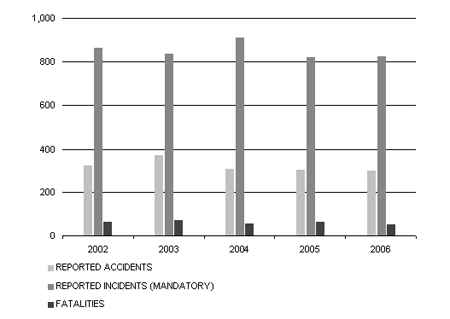 |
|
Figure 10. |
One indicator of air transportation safety in Canada is the accident rate for Canadian-registered aircraft. In 2006, this rate remained unchanged from the 2005 rate of 6.2 accidents per 100,000 hours, but was below the five-year average of 7.1. The trend line also shows a downward direction over the past 10 years.
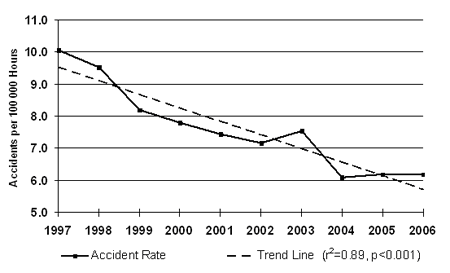 |
|
Figure 11. |
2.10.2 Investigations
A total of 41 air investigations were started in 2006-2007 and 36 investigations were completed. This represents a decrease in the number of investigations started compared to the previous year (50) and in the number of investigations completed (53). The average duration of completed investigations increased to 516 days, compared to 404 days the year before. This is attributable to concentrated efforts to complete older investigations. A complete list of all air reports released in 2006-2007 can be found in Appendix A.
|
Table 13: |
Air Productivity |
| 2002-2003 | 2003-2004 | 2004-2005 | 2005-2006 | 2006-2007 | |
| Investigations Started | 56 | 47 | 44 | 50 | 41 |
| Investigations Completed | 70 | 40 | 67 | 53 | 36 |
| Average Duration of Completed Investigations (Number of Days) | 494 | 485 | 524 | 404 | 516 |
| Recommendations | 17 | 0 | 4 | 6 | 4 |
| Safety Advisories | 13 | 9 | 9 | 7 | 16 |
| Safety Information Letters | 6 | 8 | 6 | 5 | 12 |
| Note: Results can fluctuate significantly from year to year due to a number of factors such as staff turnover, the complexity of investigations and the investigation of major occurrences. | |||||
2.10.3 Link to Resources Utilized
Table 14 provides a picture of the net cost to Canadians of air investigations. Compared to the previous year, the net cost of investigations decreased slightly. However, the average net cost per investigation completed increased by 39.3 per cent because of the scope of the investigations conducted in Canada, as well as the increased costs associated with supporting foreign investigations involving Canadian-certified operators and products. The number of investigations started and completed per investigator decreased respectively by 21.7 per cent and 35 per cent.
|
Table 14: |
Air Resources |
| 2005-2006 | 2006-2007 | |||
| FTEs | In thousands of dollars | FTEs | In thousands of dollars | |
| Actual Costs - Rail | 56.9 | 7,617 | 58.1 | 7,444 |
| Internal Professional and Communication Service Costs | 43.8 | 4,963 | 40.8 | 4,377 |
| Corporate Services Costs | 26.5 | 3,258 | 26.1 | 3,194 |
| Contributions to Employee Benefit Plans | 2,128 | 1,859 | ||
| Services Received Without Charge | 1,896 | 1,922 | ||
| Net Cost of Investigations | 127.2 | 19,861 | 125.1 | 18,797 |
| Indicators | 2005-2006 | 2006-2007 | ||
| Number of Investigators | 51.7 | 54.0 | ||
| Average Net Cost per Investigation Completed | $374,741 | $522,135 | ||
| Investigations Started by Investigator | 0.97 | 0.76 | ||
| Investigations Completed by Investigator | 1.03 | 0.67 | ||
2.10.4 Safety Actions Taken
Four air safety recommendations were issued in 2006-2007. One response was assessed as Satisfactory Intent, and initial assessments are pending for the other three.
The Air Branch assessed responses to 6 recommendations issued in 2005-2006 (details can be found in Appendix B) and reassessed responses to 35 recommendations issued in previous years. With Board approval, 7 recommendations went from active to inactive status. At the end of fiscal year 2006-2007, there were 37 active recommendations. The Board's reassessments were communicated to the appropriate change agent(s) for information and action.
2.10.4.1 Air Recommendations Issued in 2006-2007
| Reduced Power at Take-off and Collision with Terrain, MK Airlines Limited, Boeing 747-422SF, Halifax International Airport, Nova Scotia, 14 October 2004 Report No. A04H0004 |
|
| RECOMMENDATION | A06-07 The Department of Transport, in conjunction with the International Civil Aviation Organization, the Federal Aviation Administration, the European Aviation Safety Agency, and other regulatory organizations, establish a requirement for transport category aircraft to be equipped with a take-off performance monitoring system that would provide flight crews with an accurate and timely indication of inadequate take-off performance. |
| RESPONSE | Transport Canada (TC) agrees that, if a take-off performance monitoring system (TPMS) could be designed to function as intended, it could provide a significant safety benefit. However, TC believes that, in order for civil aviation authorities to establish a requirement for aircraft to be equipped with a TPMS, an acceptable system would have to
exist. TC is not aware of any certified system that is available at this time to meet this recommendation. TC states that it is conceivable that such a system could be designed with current technology. However, a significant effort would be required by private industry and researchers to establish appropriate design criteria, to perform detailed design and system development, and then to conduct significant testing to ensure high reliability before acceptance. In addition, design criteria and standards would also require harmonization with other civil aviation authorities. TC's letter also states that, at this time, TC cannot establish a requirement for aircraft to be equipped with a TPMS but will revisit this issue when a certifiable product is developed. |
| BOARD ASSESSMENT OF RESPONSE | In its response, TC states that it cannot establish a requirement for a TPMS because it does not know of any certified system available to the industry. However, TC notes TSB's suggestion that research into TPMS technology would be beneficial and consequently has formed a cross-disciplinary project team to look into this subject. TC describes what work has already been accomplished by the project team and outlines details of its action plan, which includes establishing what remains to be done before a certifiable TPMS could be made available, consulting with industry to gauge their interest in a TPMS solution, and working with industry to bring about a certifiable system. Additionally, TC invites TSB's participation in its preliminary research project team. |
| BOARD ASSESSMENT RATING | Satisfactory Intent |
| Post-Impact Fires Resulting from Small-Aircraft Accidents, Safety Issues Investigation Report No. SII A05-01 |
|
| RECOMMENDATION | A06-08 Transport Canada, together with the Federal Aviation Administration and other foreign regulators, revise the cost-benefit analysis for Notice of Proposed Rule Making 85-7A using Canadian post-impact fire statistics and current value of statistical life rates, and with consideration to the newest advances in post-impact fire prevention technology. |
| RESPONSE | Under review |
| BOARD ASSESSMENT OF RESPONSE | To be reported next fiscal year |
| BOARD ASSESSMENT RATING | Pending |
| RECOMMENDATION | A06-09 To reduce the number of post-impact fires in impact-survivable accidents involving new production aeroplanes weighing less than 5700 kg, Transport Canada, the Federal Aviation Administration, and other foreign regulators include in new aeroplane type design standards: - methods to reduce the risk of hot items becoming ignition sources; - technology designed to inert the battery and electrical systems at impact to eliminate high-temperature electrical arcing as a potential ignition source; - requirements for protective or sacrificial insulating materials in locations that are vulnerable to friction heating and sparking during accidents to eliminate friction sparking as a potential ignition source; - requirements for fuel system crashworthiness; - requirements for fuel tanks to be located as far as possible from the occupied areas of the aircraft and for fuel lines to be routed outside the occupied areas of the aircraft to increase the distance between the occupants and the fuel; and - improved standards for exits, restraint systems, and seats to enhance survivability and opportunities for occupant escape. |
| RESPONSE | Under review |
| BOARD ASSESSMENT OF RESPONSE | To be reported next fiscal year |
| BOARD ASSESSMENT RATING | Pending |
| RECOMMENDATION | A06-10 To reduce the number of post-impact fires in impact-survivable accidents involving existing production aircraft weighing less than 5700 kg, Transport Canada, the Federal Aviation Administration, and other foreign regulators conduct risk assessments to determine the feasibility of retrofitting aircraft with the following: - selected technology to eliminate hot items as a potential ignition source; - technology designed to inert the battery and electrical systems at impact to eliminate high-temperature electrical arcing as a potential ignition source; - protective or sacrificial insulating materials in locations that are vulnerable to friction heating and sparking during accidents to eliminate friction sparking as a potential ignition source; and - selected fuel system crashworthiness components that retain fuel. |
| RESPONSE | Under review |
| BOARD ASSESSMENT OF RESPONSE | To be reported next fiscal year |
| BOARD ASSESSMENT RATING | Pending |
2.10.4.2 Other Air Safety Actions
As a result of Recommendation A04-02 from investigation A04H0001, Transport Canada (TC) re-evaluated the standard weights for passengers and carry-on baggage and adjusted them for all aircraft to reflect current realities. The Federal Aviation Administration (FAA) issued Airworthiness Directive (AD) 2005-07-01 for the Cessna 208 and 208B aircraft. This AD was issued as a result of several accidents and incidents involving Cessna 208 and 208B operating in icing conditions, including this occurrence. The purpose of the AD was to ensure that pilots have enough information to prevent loss of control of the aircraft while in flight during icing conditions.
Following the receipt of TSB Safety Advisory A040058, generated by TSB investigation A04H0004, TC advised that it was developing and would soon dispatch a Commercial and Business Aviation Advisory letter concerning the need for accurate aircraft load control. As well, as a result of TSB Safety Advisory A040059 on erroneous runway slope information, TC sent an Aerodrome Safety Urgent Bulletin to airports and registered aerodromes reminding them of the need to verify published data.
During a TSB risk of collision investigation (A04Q0089), NAV CANADA undertook a major rewrite of the basic visual flight rules air traffic control training course delivered at its training facility and implemented the new curriculum. Emergency procedures are taught in instructor-led classroom activities that include the associated phraseology. Non-compliance situations by a pilot are taught in the classroom, and are practised in a number of exercises in the dynamic 360-degree airport simulator throughout the course.
During the progress of a TSB investigation into a risk of collision incident at Vancouver International Airport, British Columbia (A04P0397), the Vancouver International Airport tower manager issued an Operations Bulletin to remind controllers to adhere to the Air Traffic Control Manual of Operations (ATC MANOPS) direction to state the name of the intersection or taxiway when issuing taxi to position instructions or take-off clearances from an intersection. NAV CANADA proposed an amendment to Section RAC 4.2.8 of the Aeronautical Information Manual (AIM), which would recommend that pilots include their location with the runway number when requesting take-off clearance.
Pursuant to Safety Advisory A050012 (A05Q0024), TC indicated that it would examine the possibility of adding information on the level of runway certification to the Canada Flight Supplement, which would provide more information and details to pilots regarding any change to the certification status of a given runway.
Following occurrence investigation A05O0112 and the subsequent audit by TC, Rapid Aircraft Repair Inc. hired a Director of Quality Assurance and designated this person as the person responsible for maintenance. The company amended its Quality Assurance Program to ensure closer scrutiny in all aspects of maintenance than was previously possible; implemented a process for regular discussions on process control; implemented the process of a full-control travel check before disassembly; implemented additional training on human factors, improving the reporting of potential problems; and began implementing a safety management system.
Following the commencement of an investigation concerning an inadvertent stick shaker at high altitude (A05W0109), Bombardier Aerospace issued a message to all operators of the CRJ705/900 variants of the CL-65 emphasizing that flight operations should not be conducted below minimum drag speed as defined in the General Speed Section of the Flight Planning Cruise Control Manual for the aircraft type. Air Canada Jazz introduced a nine-module "High Altitude and High Speed Training" program for all CRJ705 pilots. TC published Commercial and Business Aviation Advisory Circular 0247 providing guidance and recommendations to operators for stall recovery training and checking, with the goal of ensuring that flight crews recognize early indications of an approach to a stall and apply the appropriate recovery actions to prevent an aeroplane from entering a stall or upset.
Following a power loss and collision with terrain investigation (A05O0125), the aircraft kit manufacturer posted aircraft information to the technical website used by international owners describing the dangers of using a particular stick grip to actuate trim and flaps.
As a result of TSB investigation A05O0147 (collision with water), the TSB determined that the pilot was able to manoeuvre into the right seat after the aircraft became inverted, but was unable to exit the aircraft. TC undertook a risk assessment, "Egress from Submerged Floatplanes," to identify the risks related to egress from submerged seaplanes and to identify the most effective means of mitigating those risks.
Following the investigation into a helicopter in-flight break-up (A05P0269), Columbia Helicopters Incorporated advised all Boeing 107 helicopter crews of the recurrent procedures to check the operation and serviceability of the speed trim actuator switches. Boeing Aerospace Support-Philadelphia issued Service Bulletin 107-67-1001, requesting that all operators of Model 107 helicopters (BV and KV) and 107 derivatives inspect and functionally test the longitudinal cyclic trim actuator limit switches. Boeing recommended that this test be accomplished before the next flight and before each subsequent flight until further notice.

